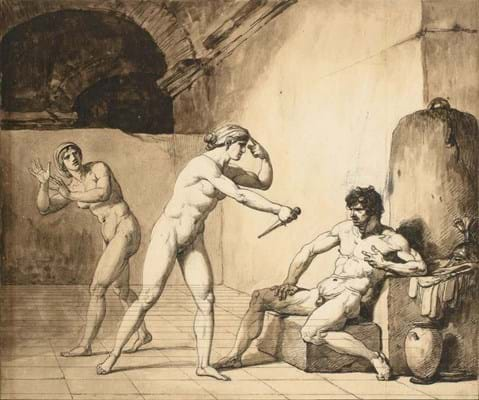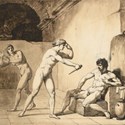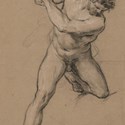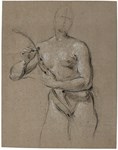In art world circles Le Tout Paris and far beyond was in town for the ever-expanding works on paper fest that constitutes drawings week.
An increasing number of dedicated auctions and shows are gathered around the 27-year-old Salon du Dessin and, as a result, enthusiasts continue to make the journey to the French capital.
As the London dealer Stephen Ongpin, in Paris to exhibit at the Salon and attend the many auctions, observed: “If you are a drawings person of any calibre as a museum curator, scholar or as a collector you make a date in your diary to be in Paris in March.”
Of course, one of the attractions of works on paper is that they are more affordable than those on canvas. Your money goes further whether in terms of age, size or stature of the artist.
For the buyer this is plainly an attraction, but now that there is so much on offer it makes for a busy week. With a plethora of choice comes a degree of selectiveness.
Featured this week and next is a series of highlights.
Huge span of works
Paris drawings week these days takes in a huge span of works on paper, from contemporary creations to classic modern or Impressionist works and 19th century names to preparatory studies for Old Masters.
The single-owner sales that formed part of this year’s event mirrored that range. As well as a very traditional collection of Old Master drawings (Sotheby’s Adrien sale), ensembles on offer had strong works on paper elements that focused more towards the Impressionist and modern fields.
The works of Edouard Vuillard were an important part of Christie’s Homage to the Hessel family, and the spotlight shone on Surrealism and Dadaism via Sotheby’s second sale of works from the Brandt Collection.
The Adrien Collection
Among the sales that Sotheby’s (25/20/12.5% buyer’s premium) put on during this period, the auction house was fortunate (and wise enough) to offer a classic provenanced collection of Old Master drawings.
The Adrien collection was just the type of fare to offer up during Drawings Week. It gave the opportunity to capitalise on the many afficionados for this material who would be making their traditional pilgrimage to the Palais Brongniart for the Salon du Dessin.
This group of drawings from France, Italy and the Low Countries, spanning the 16th to early 19th centuries, was well suited to a Paris venue, being part of a long tradition of collecting by amateurs that has flourished in the French capital. Christian and Isabelle Adrien’s approach was to follow their own inclinations and judgment, as summed up by London dealer Stephen Ongpin.
“A lot of these drawings were bought as anonymous and the Adriens would then study them or show them to various people and names would be put forward,” he said. “It wasn’t the kind of collecting where you buy a big name and show it off. It was a very Parisian way of doing things: which was that you find things at small dealers and auctions, things you like, and then study them and hopefully come up with a name. It was a very scholarly approach.”
The philosophy was also summarised by Christian Adrien himself in the introduction to Sotheby’s catalogue. He was recounting a classic purchase: a double-sided sheet that he had acquired in 1982 from the celebrated dealer/collector Jacques Petithory in a swap for half a dozen drawings from his own collection.
The drawings were not identified at the time but later revealed by an expert on the artist to be by Jean-Marc Nattier. It was linked to two of his portraits and featured in an exhibition on Nattier at Versailles.
“These are exactly the kind of factors required for a drawing to enter the Adrien Collection,” wrote Christian. “Anonymity, friendship, unusual negotiations, minimal price, followed by many years of discreet enquiries, visits by curators, experts and collectors and dealers, reattributions culminating in the drawing’s triumphant presentation on the walls of the Palace of Versailles as the finest of the artist’s 18 drawings.”
Sotheby’s produced a bilingual and extensively footnoted catalogue that did the collection proud. Come the sale on March 22, it had an audience that was dominated by buying from private collectors.
Not everything found a buyer - the selling rate was a respectable 68% and the vast majority of that sold more or less as predicted. This outcome was probably partly down to the academic nature of some of the works, but also the sheer volume of material on offer recently in this sphere (as well as the Old Masters in Paris there had also been a large volume in New York as part of February’s Old Masters series).
Nevertheless, the Adrien sale included one or two works whose performance vastly outstripped predictions and established new auction highs.
Topping the bill was a highly finished 16 x 20in (41 x 50 cm) pen, ink and wash compositional drawing c.1784 by the French neo-classical painter François André Vincent (1746-1816) for his Roman history subject Arria et Paetus, now in the Saint Louis Art Museum in the US.
The Adriens acquired their drawing in 1986 in Bordeaux from the Galerie Guy Imberti. Last month at Sotheby’s it outstripped the €80,000-120,000 guide to take €380,000 (£345,455), a new auction record for the artist.
Similarly, a new high was set for François Lemoyne (1688-1737) courtesy of his 16 x 10in (41 x 25cm) chalk figure of Hercules, a preparatory work for Hercules defeating Cacus, the artist’s reception piece for the Académie Royale de Peinture et Sculpture in 1718. It was acquired back in 1970 for the equivalent of €38 as an anonymous drawing spotted among a portfolio in a Parisian shop, and is one of a small handful of preparatory drawings for the painting (including one in the Louvre).
Estimated at €50,000-70,000, it sailed past this level to take €240,000 (£218,180) which, like the Vincent, was an auction record for a drawing by the artist.
Homage to the Hessels
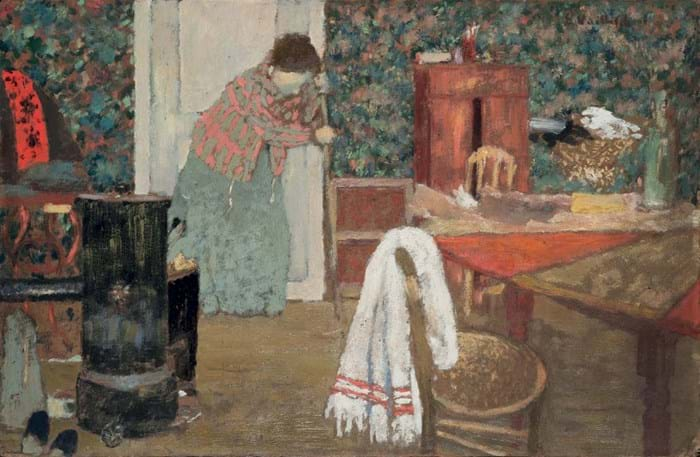
La Balayeuse, by Edouard Vuillard, showing the interior of his family apartment on the rue St Honoré, which topped Christie’s sale of works collected by Jos and Lucy Hessel at €1.78m (£1.6m).
Christie’s (25/20/12.5% buyer’s premium) offered a mixed-owner Old Masters sale but the auction house’s single-owner offering fitted into the Impressionist and modern framework.
This was a group of 28 lots by French modern artists, a mix of pastels on paper, pencil drawings and substantial oil paintings on card applied onto canvas as well as the occasional oil on canvas. Seventeen of the works were by the Nabis artist Edouard Vuillard (1868-1940).
They had been assembled by Jos Hessel (1859-1942) and his wife Lucy, who knew Vuillard for over 40 years – Jos as his dealer and Lucy as his muse and model. The collection had passed down via their descendants.
A handful of works by Bonnard were also on offer and around half a dozen individual pieces by artists such as Maillol, Marie Laurencin and Maurice Denis. In many cases Lucy Hessel was the subject of these paintings and drawings.
Estimates varied considerably, depending on the complexity or substance of the work, from finished stand-alone paintings to ink or pencil studies and sketches. Every lot found a buyer. Half a dozen works went over estimate and just over 40% got away below expectations, while the remaining 35% sold as predicted.
The best-seller proved to be La Balayeuse of 1895, an early work from Vuillard’s career when artist and the Hessels had just met.
The 13 x 20in (33 x 51cm) signed painting in oil on cardboard laid on panel features a domestic scene set in the Vuillard’s family apartment on the rue Saint Honoré, which the artist’s mother had turned into a live/ work space by setting up a clothing workshop. It was one of the paintings that surpassed its estimate, taking €1.78m (£1.6m) against predictions of €1m-1.5m.
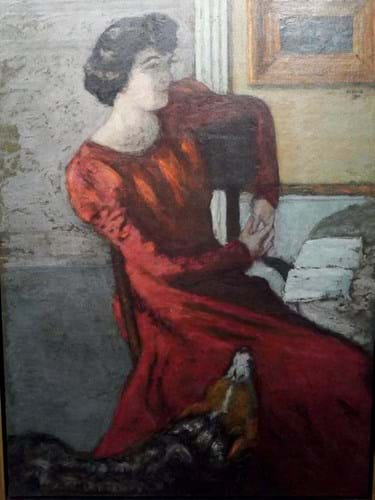
Pierre Bonnard’s oil on cardboard of Lucy Hessel in a red dress – €310,000 (£281,820) at Christie’s Hessel collection auction.
The most expensive of the many portraits of Lucy Hessel in the collection, at €310,000 (£281,820), was Pierre Bonnard’s (1867-1947) La Dame en Rouge of 1901, a 3ft 7in x 2ft 7in (1.1m x 80cm) oil on cardboard portrait showing her seated in an interior in a striking red dress that dominates the scene.
It was just surpassed, however, at €330,000 (£300,000) by another Bonnard, La Toilette, one of the artist’s typical intimiste scenes. This 2ft 3in x 3ft (68 x 91cm) oil on canvas of c.1907 depicts his model and future wife Marthe about to bathe.
An auction high emerged for another artist of the Nabis group: Maurice Denis. His 18 x 15¾in (45 x 40cm) gouache on cardboard Legende de Chevalerie or Trois Jeunes Princesses, painted in Brittany in 1893, doubled the lower estimate at €580,000 (£527,270).


